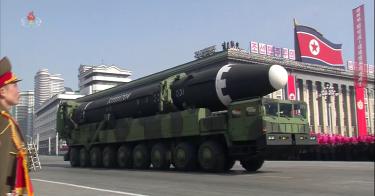It’s obvious why the bluster and brinksmanship over the nuclear-missile situation between the U.S. and North Korea produces so much tension: If an ICBM were launched at us or one of our allies, what could we do?
We’re not completely vulnerable, though, and for a very good reason: We have a missile-defense system in place. And for that, we can thank the man who unveiled the Strategic Defense Initiative (SDI) 35 years ago. President Reagan’s address to the nation on March 23, 1983, was a real game-changer.
How ironic that a president derided by his critics as a war-monger would be the one to envision a world in which nuclear missiles were rendered virtually powerless. Yet it was this so-called “cowboy” who looked at the policy that had governed relations between the U.S. and the Soviet Union for decades, and realized that it had to change.
That policy, known as “mutually assured destruction,” or MAD, basically amounted to a stalemate. The peace was kept solely because each side possessed more than enough firepower to retaliate on a massive scale. But this policy meant that each side also had every incentive to keep adding more and bigger ICBMs to keep from falling behind.
“Somehow this didn’t seem to me to be something that would send you to bed feeling safe,” Mr. Reagan wrote in his autobiography. “It was like having two Westerners standing in a saloon aiming their guns at each other’s head — permanently. There had to be a better way.”
There was. Mr. Reagan spoke with the Joint Chiefs of Staff about the feasibility of that new way: creating a system that would destroy incoming ICBMs before they could deliver their deadly payload. They agreed that it was an idea worth exploring — and SDI was born.
It wasn’t without controversy, of course. Skeptics said you couldn’t “hit a bullet with a bullet.” Many successful tests later, we know otherwise. But even before we had a track record to point to, you have to ask yourself why anyone would be unwilling to try. Wouldn’t it be an improvement over the status quo?
The Soviets, of course, weren’t buying it. They were convinced it was a ruse, a trick, a bargaining chip of some kind. The idea that the American president was actually sincere was apparently the only possibility they didn’t consider.
“I’ve had to tell the Soviet leaders a hundred times that the SDI was not a bargaining chip,” Mr. Reagan wrote. “I’ve told them I’d share it with others willing to give up their nuclear missiles. We all know how to make the missiles. One day a madman could come along and make the missiles and blackmail all of us, but not if we have a defense against them.”
That last sentence, of course, shows how forward-thinking Mr. Reagan was. Because in 2018, the nature of the threats facing the United States have indeed changed. We are dealing with many more adversaries than just the Soviet Union, and we know even less about them than we did about the Soviets.
Fortunately, thanks to SDI and the programs that developed in its wake, we have at least a basic missile defense in place today. But it’s been hampered at times by its political foes, and so it remains not nearly as well-developed as it could be.
We have land-based missile-defense interceptors, but we need to invest in space-based ones as well. We should also develop and deploy directed-energy weapons, building on the research and development legacy of the SDI program. With ballistic missile technologies proliferating at a rapid rate, the task is more urgent than ever.
“Our only purpose — one all people share — is to search for ways to reduce the danger of nuclear war,” Mr. Reagan told the nation on March 23, 1983. A more robust missile defense is one of the primary ways we can do that. Let’s get back to work.
This piece originally appeared in the Washington Times




